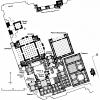The Apadana at Persepolis
Commentary
The Apadana, constructed under Darius I, is usually interpreted as a monumental audience chamber. It is a columned hall (60x60m) with 36 internal columns, with large porticos to N, W, and E; the famous 'tribute-delegation' reliefs are carved on the staircase leading to the E portico.
Below the corner-walls of the Apadana were placed four 'foundation deposits' (two of which have been recovered), consisting of stone boxes each containing a pair of gold and silver plaques inscribed with a trilingual foundation inscription (DPh: translation here). Below the boxes were found a small number of Lydian gold and Greek silver coins, probably the remains of a symbolic deposit of objects from the outer peripheries of the Achaemenid empire; the coins presumably symbolise the far north-western limit of Achaemenid power.
For the foundation deposits, see Margaret Cool Root, 'The Persian archer at Persepolis: aspects of chronology, style and symbolism', Revue des etudes anciennes 91 (1989) 33-50.

